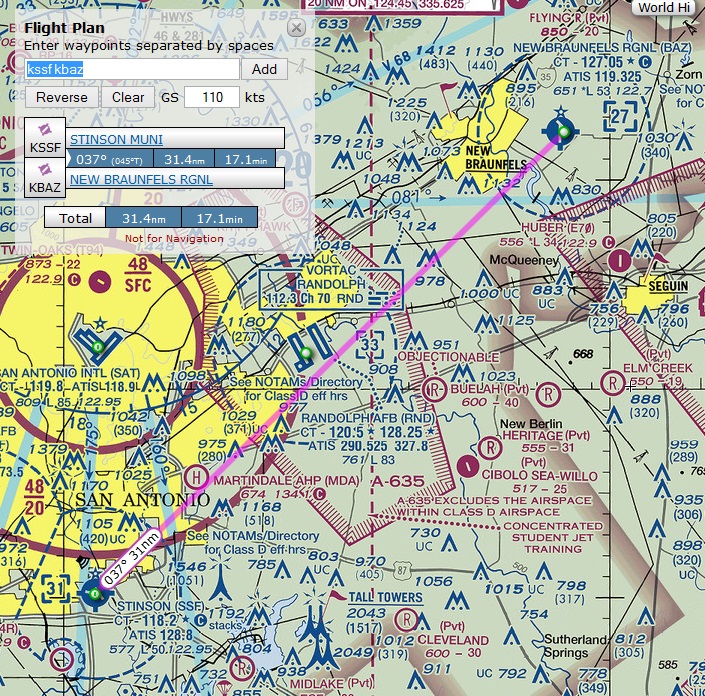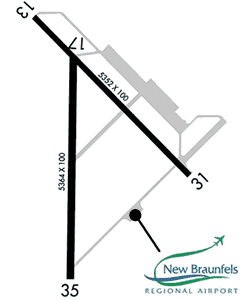So far during my primary flight training, the approach slope indicator lights haven’t really been something I used or worried about. Landing my little Cessna on a 4,000+ foot strip in broad daylight has gotten easier and easier, and even when I was terrible I was more concerned about flying a stabilized approach than being “on” the glideslope. Sure a quick glance now and again to confirm that I wasn’t too low has been helpful, but it wasn’t among the tools I relied upon to bring me safely into the airport. And then I flew at night, and realized exactly how useful that little strip of lights can become.
Last week I had finally progressed to the point where I was comfortable flying alone during the day, and so it was time to turn off the lights and crank up the difficulty. My flight instructor and I planned a quick night flight across San Antonio — directly from Stinson (KSSF) to New Braunfels (KBAZ) and back. It was long enough to get some good instruction during the cruise, but not so long as to meet the 50 nautical mile cross country criteria.
Before taking off, we checked all the usual things; takeoff and landing distance, available runways, applicable NOTAMs… the normal stuff. But the one thing I didn’t think to check before taking off was whether the runway I planned to use had any approach slope indicator lighting. I just checked that the sectional indicated that the field was lit and had a rotating beacon (L with a star) and figured we would be good to go.
The takeoff and cruse was normal, we skirted the southeast portion of San Antonio’s class charlie airspace and arrived almost exactly on time as per our flight plan. But when we took our first look at the field, I became a little nervous. I passed the FAA written exam already so I had heard about “black hole” approaches, but I had never seen one. Now, on my first time up at night, landing for the first time after dark, I was presented with a “black hole” approach into an airport I’d never visited before without any glideslope indications.
Looking down on the field, all I could see were the runway lights and the rotating beacon. The rest of the field could have been a lake for all I knew — I couldn’t see anything. My primary concern was that there were some unlit power lines or tall trees that I couldn’t see from the air, and while I had my landing and taxi lights on it still didn’t quite flood the area with light. It was a lot blacker than I anticipated, and if I didn’t have the CFI sitting in the right seat I probably would have turned around and headed home. Heck, even with him in the cockpit that might have been the smart call.
Landing in that situation was the most stressful thing I’ve done since the first time I ever landed an airplane. I used the same strategy for landing that I had used during the day, but since I was landing at a completely new airport and had no idea how the surrounding area looked I wasn’t confident at all. As soon as the landing gear touched down on the pavement, all I wanted to do was hit the power and head back to Stinson.
Back at my home airport, things were very different. Where New Braunfels was a sparsely lit black hole with no approach path indicators, Stinson was a veritable shining beacon in the night. Pulsating white lights at the runway edges, a beautifully lit apron, and the best thing I had seen all night: a PAPI. Instead of worrying about whether I was going to hit a treetop every couple of seconds, the PAPI allowed me to focus my attention on flying a perfect approach and landing.
In the end, I learned two valuable lessons from my first night flight.
The first lesson was to always check the airport diagram for the airport I’m about to fly into, and always carry a copy in the cockpit. When I landed at KBAZ, I had to whip out the AFD just to figure out where I was and how to taxi back to the beginning of the runway. Things get hairy in the night, and while you can figure it out on the fly during the daytime it can be very difficult at night. Also, checking the AFD tells me if the runway I’m about to land on has a visual approach path indicator, something I will require for myself for all night landings for the time being.
Lesson number two was that while the PAPI isn’t necessarily required for making successful night landings, it’s something that makes the process a lot easier. In fact, it’s so helpful that I’d be willing to change destination airports just to find one. The reason isn’t that I’m concerned about landing too short or long at night — I did it just fine without a PAPI at KBAZ — the reason is that it gives me peace of mind. I know that when I can only see one red light, I’m well clear of any obstructions on the ground that I can’t see.
I’m happy that I have a “black hole” approach under my belt, but I’m willing to do some extra legwork and extra flying to ensure that the number doesn’t increase.

